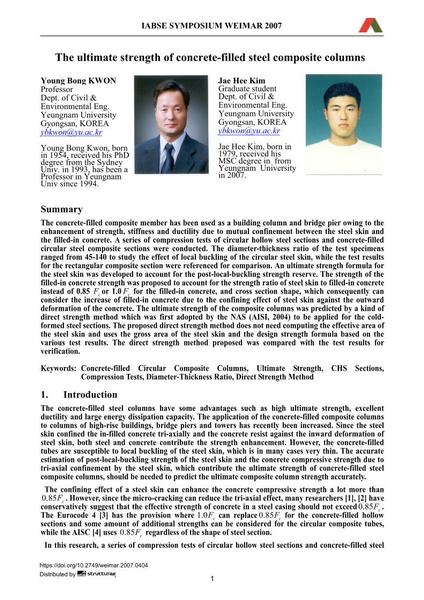The ultimate strength of concrete-filled composite columns

|
|
|||||||||||
Bibliografische Angaben
| Autor(en): |
Young Bong Kwon
Jae Hee Kim |
||||
|---|---|---|---|---|---|
| Medium: | Tagungsbeitrag | ||||
| Sprache(n): | Englisch | ||||
| Tagung: | IABSE Symposium: Improving Infrastructure Worldwide, Weimar, Germany, 19-21 September 2007 | ||||
| Veröffentlicht in: | IABSE Symposium Weimar 2007 | ||||
|
|||||
| Seite(n): | 500-501 | ||||
| Anzahl der Seiten (im PDF): | 8 | ||||
| Jahr: | 2007 | ||||
| DOI: | 10.2749/weimar.2007.0404 | ||||
| Abstrakt: |
The concrete-filled composite member has been used as a building column and bridge pier owing to the enhancement of strength, stiffness and ductility due to mutual confinement between the steel skin and the filled-in concrete. A series of compression tests of circular hollow steel sections and concrete-filled circular steel composite sections were conducted. The diameter-thickness ratio of the test specimens ranged from 45-140 to study the effect of local buckling of the circular steel skin, while the test results for the rectangular composite section were referenced for comparison. An ultimate strength formula for the steel skin was developed to account for the post-local-buckling strength reserve. The strength of the filled-in concrete strength was proposed to account for the strength ratio of steel skin to filled-in concrete instead of 0.85 Fc or 1.0 Fc for the filled-in concrete, and cross section shape, which consequently can consider the increase of filled-in concrete due to the confining effect of steel skin against the outward deformation of the concrete. The ultimate strength of the composite columns was predicted by a kind of direct strength method which was first adopted by the NAS (AISI, 2004) to be applied for the cold-formed steel sections. The proposed direct strength method does not need computing the effective area of the steel skin and uses the gross area of the steel skin and the design strength formula based on the various test results. The direct strength method proposed was compared with the test results for verification. |
||||
